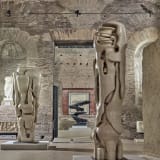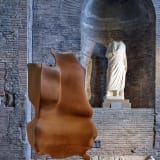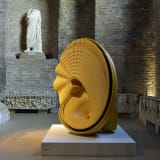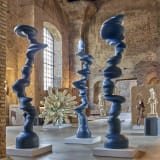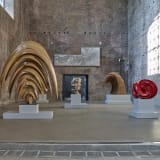Tony Cragg - Infinite forme e bellissime Museo Nazionale Romano Terme di Diocleziano
Museo Nazionale Romano presents Tony Cragg: Infinite forme e bellissime, curated by Sergio Risaliti and Stéphane Verger, at the Baths of Diocletian. Since the 1970s, Cragg has been recognized for his innovative exploration of forms, materials, and techniques. The exhibition is organized by BAM – Eventi d'Arte in progettazione with Municipio I Roma Centro.
The exhibition brings to the rooms full of history of the Baths of Diocletian—with its imposing halls, covered by very large vaults—eighteen sculptures, of medium and large size, made in the last two decades in bronze, wood, travertine, fiberglass and steel: seductive, disturbing, mysterious shapes—which now refer to the mineral and plant world, now to geology and biology, evoking the waves of the sea, the geometric structures of a plant or a shell—which now enter into dialogue with the archaeological spaces of the monumental complex.
Cragg's artistic research has always been focused on the infinite possibilities of drawing and sculpture, in an unstoppable confrontation with nature, with its creative processes and its evolutionary structures. Infinite and beautiful forms, a topical phrase by Charles Darwin, evokes the artist's unstoppable enthusiasm in the face of the richness of the architectures of life, from the microcosm to the macrocosm, on the one hand, and the wonder that thought arousesnever satisfied with sinking into the knowledge of reality, into the inexhaustible wealth of forms and models, of structures and generative processes that the natural world puts before our eyes: a richness to which corresponds the work of the artist, in particular that of the sculptor, who can 'think' and create new forms without setting limits in the use of means and materials. A fruitful exchange of intuitions and images between natural and artificial, between biomorphic and virtual models, which derive from the observation of the organic compositions and crystalline structures of minerals, to the point of involving digitally processed forms and products artificially born in the laboratory: from archaeology to geology, from art history to biology. The title thus resonates with the scientist Darwin's enthusiasm for natural forms and his evolutionary processes, which expressed himself as follows: "There is something great in this conception of life, with its many capacities, which was initially given to a few forms or to only one and which, while the planet continues to revolve according to the immutable law of gravity, It has evolved and evolves, starting from such simple beginnings, to creating endless extremely beautiful and wonderful shapes."
In his process, Cragg continuously picks up, creates, manipulates and distorts form, to give life to absolutely surprising sculptures that, moving between abstraction and figuration, can evoke natural landscapes as well as represent human bodies and everyday objects. The works are conceived as complex and dynamic structures, which test physical and structural limits, trying to resolve the relationship between matter and technique, between empty and full, between instability and balance. Generated by a root that, like a monad, supports them from the center, they unravel to generate many different ramifications, without neglecting the physical, material presence, with its expressive qualities and energies, imitating what nature does with its forms, in a direction opposite to functionalism and utilitarianism—to which industry and design aim—as well as to the virtual and augmented reality.
For Cragg, sculpture is not only a method of investigation, development of knowledge, dialogue between perceptions and imaginations, the physical world and the imagination: in his practice it has in particular a pedagogical function, it is an infinite exercise of knowledge, a way of thinking that develops between intuitive and creative processes, in a continuous dialogue between levels and interrelationships of visible and invisible, of large and small, in a fluid and dynamic way, never static and definitive.
"In reality," Cragg points out, "sculpture is only at the beginning of its history. What if it was just being born now? And if the idea of sculpture was not about the creation of an ornament for the world but, directly, about an instrument of investigation."
With this exhibition, visitors are asked to have an experience that involves the senses and imagination, thought and sight, the organ on which our relationship with the world of forms depends, even when it comes to levels of reality invisible to the naked eye.





